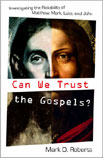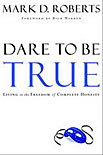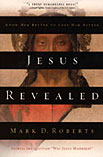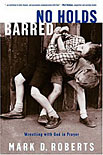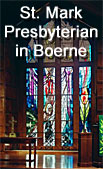My blog has moved! http://www.patheos.com/blogs/markdroberts/
|
 |
Twitter Feed for My Recent Blog Posts and Other Tweets |
My blog has moved! http://www.patheos.com/blogs/markdroberts/
|
Easter Reflections
By Mark D. Roberts | Wednesday, April 15, 2009
 Recently Ben Witherington III spoke at a Laity Lodge retreat. Ben, as you may know, is a leading New Testament scholar with impressive credentials. (When I printed his list of publications from his website, it took ten pages!) Ben also has one of the most informative and delightful blogs in the blogosphere. You’ll never know whether he’ll put up a weighty piece of biblical scholarship or some silly pictures of animals. (Photo: Ben Witherington holding forth at Laity Lodge.)
Recently Ben Witherington III spoke at a Laity Lodge retreat. Ben, as you may know, is a leading New Testament scholar with impressive credentials. (When I printed his list of publications from his website, it took ten pages!) Ben also has one of the most informative and delightful blogs in the blogosphere. You’ll never know whether he’ll put up a weighty piece of biblical scholarship or some silly pictures of animals. (Photo: Ben Witherington holding forth at Laity Lodge.)
Ben is also an engaging speakers. He’s one of those unusual scholars who is able to communicate warmly (and often hilariously) with a lay audience. At Laity Lodge he did a four-part series on the Johannine literature, focusing on some of the major themes found in the the Gospel of John and the Revelation of John.
One of Ben’s messages focused on the resurrection appearance of Jesus to Peter and the other disciples in John 21. In a nutshell, the disciples go fishing on the Sea of Tiberias (Galilee) after Jesus was raised. They fish all night, but catch nothing. In early morning, Jesus appears on shore and tells them to cast their net on the other side of the boat. Promptly they have so many fish in their net that they can’t even bring it into the boat. Realizing who’s on the beach, Peter swims to meet Jesus. There he and Jesus have a conversation as they are warmed by a “charcoal fire” (21:9). Jesus asks Peter three times, “Do you love me?” Three times Peter professes his love for Jesus. By the third time he is grieved, no doubt because it seems as if Jesus hasn’t believed his earlier professions.
Ben Witherington pointed out a strong connection between this story and the one we find in 18:15-27. There, in fulfillment of Jesus’ earlier prophecy, Peter denied Jesus three times. These rejections of Jesus happened, according to John, as Peter warmed himself by a “charcoal fire” (18:18). The Greek word anthrakia, which means “charcoal fire,” appears only this verse and in John 21:9 in the whole New Testament. Thus, John clearly means to connect the dots between Peter’s denial of Jesus in John 18 and his encounter with Jesus in John 21. In both texts we have a conversation next to a “charcoal fire.” In one passage, Peter is asked three times about his relatioship to Jesus, and three times he denies a connection. In the other passage, Peter is asked three times about his relationship to Jesus, and three times he professes his love for Jesus.
Ben Witherington shows that John 21 is a story of Peter’s redemption. Jesus seeks out Pete, places him by a charcoal fire, and asks him three questions in order to redeem what was lost in Peter’s earlier denial. Implicit in this scene is the awesome mercy of Jesus, who offers forgiveness and restoration. Moreover, Jesus authorizes Peter to take care of his “sheep.” Not only is Peter restored in his relationship with Jesus, but also he is given authority in the soon-to-be-formed church.
This story of Peter speaks pointedly to any of us who have denied Jesus. And which of us has not denied Jesus in some way? Perhaps we’ve never been quite so blunt as Peter. But we have denied Jesus in a variety of ways. Maybe you’ve been in a conversation where people have been speaking poorly of him, but you chose to remain silent. Or maybe you’ve spoken clearly of your faith in him, but turned around to deny him by your actions. The good news for us in John 21 is that Jesus forgives, restores, and uses even people like Peter . . . and me . . . and you.
Topics: Easter | 6 Comments »
Vintage 21 Hosts Advance: Resurgence of the Local Church
By Mark D. Roberts | Tuesday, April 14, 2009

I’ve been asked by the folks at Vintage 21, a church in Raleigh, North Carolina, to put in a good word for their upcoming conference: Advance: Resurgence of the Local Church. Here’s their vision for the conference:
Christ promises to build the Church, and that no force will prevail against it. Yet, the local church has been heavily battered in battle. Sadly, churches in America are in steady decline, with over 4000 closing their doors and 500,000 members leaving each year–never to return. This is not what the Lord desires. The Apostle Paul tells us that ” . . . through the church the manifold wisdom of God might now be made known to the rulers and authorities in the heavenly places”. The local church is called to lift-up Jesus so that all the world might see Him. The local church is called to make known the Gospel and to be the vehicle of redemption for the world. Led by local churches, Advance09 is a conference committed to the resurgence of the local church for the glory of God. Our aim is to equip attendees with the Gospel so that the local church might become all that Jesus calls it to be. At this conference, we hope to ensure that on our watch and in our time we honor Jesus and see the resurgence of the local church. Advance09 is open to anyone: pastors and lay-leaders; church members and regular-attenders. We invite you to join us in this Great Cause.
They’ve gathered an impressive array of speakers, including John Piper and Mark Driscoll. (That’s a combination I would like to see!). If you register before April 17, you can get a discount.
I became aware of Vintage 21 a few years ago through a series of videos they created. These are some of the most creative, funny, insightful, and well-known of all Christian videos on the Internet. Many if not most of my readers will have seen them. But if you haven’t, I’d encourage you to check out the Vintage 21 Jesus series. You can see all videos in the link below. Together, they last only about nine minutes.
Topics: Recommendations | 1 Comment »
The Stations of the Resurrection!
By Mark D. Roberts | Monday, April 13, 2009
Christ is risen!
He is risen, indeed!
Yes, I know Easter Sunday was yesterday. But, for Christians throughout the world, Easter is not just a day, but a 50-day season, beginning with Easter Sunday and continuing to Pentecost. So today I continue my reflections on Easter.
If you’re looking for what I’ve written before on the season of Easter, you can check out:
If you’ve been reading my blog for the last couple of of week, you know that I’ve been focusing on a biblical version of the Stations of the Cross. It’s a way for Christians to reflect upon the meaning of Christ’s death, so that they might have a deeper personal knowledge of God’s grace in Christ.
The last of the fourteen stations has the title: Jesus is Placed in the Tomb. As I mentioned in yesterday’s post, the Stations of the Cross end here. There is no Easter station, for obvious reasons. Yet, a part of me wishes that the stations continued into Eastertide. Wouldn’t it be wonderful to be led into a more profound understanding and experience of the resurrection of Jesus?!
 In fact, The Stations of the Resurrection do exist, though they are a recent creation, unlike The Stations of the Cross. They were formulated by a man named Don Sabino Palumbieri. A theological anthropologist by profession, Palumbieri founded an organization called Movimento Testimoni del Risorto (Movement of the Witnesses of the Risen Lord). The purpose of this movement is to help ordinary Christians understand and experience the resurrection of Christ in their lives, so that the world might be impacted by the power of the resurrection.
In fact, The Stations of the Resurrection do exist, though they are a recent creation, unlike The Stations of the Cross. They were formulated by a man named Don Sabino Palumbieri. A theological anthropologist by profession, Palumbieri founded an organization called Movimento Testimoni del Risorto (Movement of the Witnesses of the Risen Lord). The purpose of this movement is to help ordinary Christians understand and experience the resurrection of Christ in their lives, so that the world might be impacted by the power of the resurrection.
 As part of his mission to help people experience resurrection reality today, in the 1980s Palumbieri began to formulate the Via Lucis (”the way of light” in Latin) which complemented the Via Crucis (”the way of the cross,” another name for the Stations of the Cross). Each station in the Via Lucis is based on a specific biblical passage, like the revised Via Crucis I have used as the basis for my own reflections. The first Via Lucis was celebrated in in the Catacombs of St. Callistus in Rome. Shortly thereafter Pope John Paul II became aware of the Via Lucis. It was officially sanctioned by the Vatican in 2001, in the Directory on Popular Piety and the Liturgy: Principles and Guidelines: Chapter 4: The Liturgical Year and Popular Piety, Section 153. (Photos: Inside the Catacomb of St. Callistus. I had the privilege of touring this catacomb in 2004. The photos are not mine, however, since ordinary tourists are not allowed to take pictures there.)
As part of his mission to help people experience resurrection reality today, in the 1980s Palumbieri began to formulate the Via Lucis (”the way of light” in Latin) which complemented the Via Crucis (”the way of the cross,” another name for the Stations of the Cross). Each station in the Via Lucis is based on a specific biblical passage, like the revised Via Crucis I have used as the basis for my own reflections. The first Via Lucis was celebrated in in the Catacombs of St. Callistus in Rome. Shortly thereafter Pope John Paul II became aware of the Via Lucis. It was officially sanctioned by the Vatican in 2001, in the Directory on Popular Piety and the Liturgy: Principles and Guidelines: Chapter 4: The Liturgical Year and Popular Piety, Section 153. (Photos: Inside the Catacomb of St. Callistus. I had the privilege of touring this catacomb in 2004. The photos are not mine, however, since ordinary tourists are not allowed to take pictures there.)
The Archdiocese of Detroit has published a form of The Stations of the Resurrection, including devotional resources for each day. Here is the list of the fourteen stations:
First Station: Jesus Rises from the Dead
Second Station: Women Come to the Tomb Encountering an Angel
Third Station: Peter and John Visit the Tomb with Mary Magdalene
Fourth Station: Jesus Appears to Mary Magdalene
Fifth Station: Mary Magdalene Proclaims His Rising to the Apostles
Sixth Station: Jesus Appears on the Road to Emmaus
Seventh Station: Jesus Gives the Disciples the Power to Forgive
Eighth Station: Jesus Confirms the Faith of Thomas
Ninth Station: Jesus Eats with the Disciples on Tiberias Shore
Tenth Station: Jesus Forgives Peter and Commissions Him
Eleventh Station: Jesus Gives the Great Commission to the Disciples
Twelfth Station: Jesus Ascends into Heaven
Thirteenth Station: Mary and the Disciples Keep Vigil for the Spirit’s
Advent
Fourteenth Station: Jesus Sends the Holy Spirit
You can find devotional resources for today’s reflection here.
Because of several blogging commitments, I am not able to offer a series on The Stations of the Resurrection this year. But I’m seriously thinking about doing it next year. Perhaps I can even persuade my wife to do some paintings. I know that I need a deeper understanding and experience of the resurrection, and I expect you do too. For now, I’d point you to the resources I mentioned above.
May you have a blessed Eastertide!
Topics: Easter | 3 Comments »
The Stations of the Cross: An Easter Postscript
By Mark D. Roberts | Sunday, April 12, 2009
 Christ is risen!
Christ is risen!
He is risen, indeed!
So Christians have proclaimed for centuries on Easter morning, as we celebrate the resurrection of Jesus. (Photo: A painting of the resurrection of Christ by Matthias Grünewald, c. 1515. I changed the shape a bit to fit this space. This was originally an altarpiece for the Monastery of St. Anthony in Isenheim [once in Germany], now France. Today it is in the Unterlinden Museum in Colmar, France.)
For the past fourteen days, I have been reflecting on the Stations of the Cross in preparation for a deeper experience of the reality of Jesus’ death, and therefore a greater celebration of his resurrection.
Without the resurrection, the cross of Jesus really wouldn’t matter much.
Without the resurrection, we’d never have known about Jesus’ prayer on the Mount of Olives, where he submitted to the will of his Heavenly Father.
Without the resurrection, Judas’ betrayal of Jesus would have been long forgotten.
Without the resurrection, the Sanhedrin who condemned Jesus would have been seen as largely correct in their estimation of him as a blasphemer who needed to be silenced.
Without the resurrection, Peter’s denial of Jesus might seem like a judicious way to preserve his own life.
Without the resurrection, we’d probably never have heard the name of Pontius Pilate, unless we happened to take a class in Jewish history.
Without the resurrection, the fact that Jesus was scourged and crowned with thorns would seem to be a sad but fitting end to one who pretended to usher in the kingdom of God.
Without the resurrection, Jesus would have been one more nameless individual who took up his cross on the way to dying a cruel death.
Without the resurrection, Simon of Cyrene would have disappeared into the dust of history.
Without the resurrection, the women who mourned for Jesus would have continued to mourn for a long, long time . . . not for only two days.
Without the resurrection, most of us would know very little about crucifixion, unless we had seen the movie Spartacus.
Without the resurrection, the promise of Jesus to the thief, that he would join Jesus in Paradise, would seem like a bad, sad joke.
Without the resurrection, the presence of Jesus’ mother at the cross would be painful in the extreme, without a hint of meaning or hope.
Without the resurrection, the cross would be largely forgotten, and it would not appear on millions of buildings or around millions of necks.
Without the resurrection, the tomb would have been the final resting place of Jesus, untill his body was exhumed so his bones could be placed in a ossuary.
Without the resurrection, there would be no Stations of the Cross.
Without the resurrection, there would be no Christian church.
Without the resurrection, there would be no assurance of salvation.
Without the resurrection, there would be no reason to hope.
Without the resurrection, there would be only death.
Because of the resurrection, we reverence the cross.
Because of the resurrection, the symbol of the cross is one of the best known in the world.
Because of the resurrection, what was once the sign of horrific death is now a sign of life and hope.
Because of the resurrection, the death of Jesus is remembered, cherished, even celebrated.
Because of the resurrection, the Stations of the Cross lead, not to death, but to live.
Because of the resurrection, we are reborn into a living hope.
Because of the resurrection, we know that we too will live anew.
Because of the resurrection, everything is different.
Because of the resurrection, new life has begun.
Christ is risen!
He is risen, indeed!
Topics: Easter | 3 Comments »
The Fourteenth Station: Jesus is Placed in the Tomb
By Mark D. Roberts | Saturday, April 11, 2009
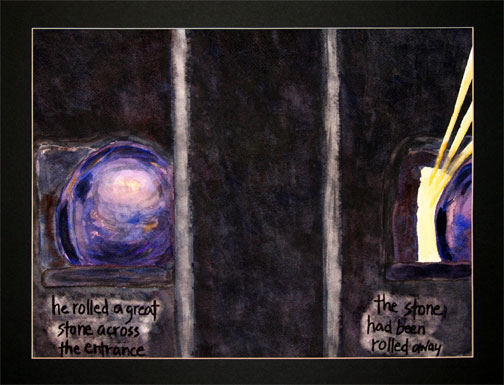
Copyright © Linda Roberts, 2007.
For permission to use this picture, please contact Mark D. Roberts
Luke 23:50-54; Mark 16:1-4
Luke 23:50 Now there was a good and righteous man named Joseph, who, though a member of the council, 51 had not agreed to their plan and action. He came from the Jewish town of Arimathea, and he was waiting expectantly for the kingdom of God. 52 This man went to Pilate and asked for the body of Jesus. 53 Then he took it down, wrapped it in a linen cloth, and laid it in a rock-hewn tomb where no one had ever been laid. 54 It was the day of Preparation, and the sabbath was beginning.
Mark 16:1 When the sabbath was over, Mary Magdalene, and Mary the mother of James, and Salome bought spices, so that they might go and anoint him. 2 And very early on the first day of the week, when the sun had risen, they went to the tomb. 3 They had been saying to one another, “Who will roll away the stone for us from the entrance to the tomb?” 4 When they looked up, they saw that the stone, which was very large, had already been rolled back.
Reflection
After Jesus died, His body was placed in a tomb. This was better treatment than most crucified people would have received. Their bodies were often discarded by Roman soldiers and left exposed, unless they had families or friends nearby to care for them. The body of Jesus was fortunate enough to receive unusual attention from a man named Joseph, who was both a member of the Sanhedrin and a follower of Jesus. He made sure the body of his Master was appropriately buried, so that, later, the bones of Jesus could be finally interred in an ossuary (a special box for bones). Little did Joseph know that God had other plans for the body of Jesus.
In most human societies, appropriate burial of dead bodies is a sacred tradition. It matters profoundly that we ensure the proper resting place for those who have died. Yet, after burials happen, we don’t generally mention them specifically. My father died in 1986. I’ve spoken of his death probably 500 times since then, but I don’t think I’ve ever said “My dad died in 1986 and then he was buried.” Burial, however significant to us, is something we assume and don’t need to point out specifically. If I say “My dad died” you rightly assume that he was buried (or, perhaps, creamated and dealt with in an honorable fashion).
Therefore, it’s notable that all four biblical Gospels describe the burial of Jesus and the help of Joseph of Arimathea. Moreover, the very earliest summary of the Christian message also contained explicit reference to Jesus’ burial. The Apostle Paul, writing to Christians in Corinth about twenty years after Jesus’s death, summarized the basic Christian good news in this way:
For I handed on to you as of first importance what I in turn had received:
that Christ died for our sins in accordance with the scriptures,
and that he was buried,
and that he was raised on the third day in accordance with the scriptures,
and that he appeared to Cephas, then to the twelve.
(1 Corinthians 15:3-5)
There it sits, unadorned but essential: “and that he was buried.” Why? Why did the earliest Christians, and then why did the writers of the Gospels, consider it so important to mention the actual burial of Jesus?
To put the question a different way, what does “and that he was buried” add to the essential Christian message? For one thing, it prepares the way for the affirmation of the resurrection. To say that Jesus died and was raised without mentioning his burial could lead to a misunderstanding of the story. One might think that Jesus was immediately brought back to life from the cross, or that he was immediately jettisoned to heaven. “And that he was buried” eliminates these options, and explains the place from which Jesus was raised.
But, more important by far, the mention of the burial of Jesus makes it absolutely clear that Jesus really died on the cross. He didn’t just appear to die, as was once proposed by Hugh Schoenfield in his bestselling book, The Passover Plot. Schoenfield’s “swoon theory” has been discredited by scholars of all theological stripes. Whatever else can be known about Jesus, all the evidence, from both biblical and extra-biblical sources, points to the simple fact that he really died upon the cross. When the earliest Christians proclaimed the burial of Jesus, they were saying, in effect, that he really, really died. Had Charles Dickens been among the first Christians, he might have written that Jesus was a dead as a doornail, just like Jacob Marley. (Or would it have been a “cross-nail”?)
I don’t mean to suggest that Jesus’ death, a fairly mundane historical fact, is easy to parse out theologically. After all, Jesus was not just a man, but the God-man. He was the Word of God in flesh, the One in whom was life and who was the source of all life (John 1:1-14). The Jesus died physically, and that, in the process, he suffered the penalty of spiritual death for sin, are mysteries far beyond our ability to fully fathom. How could the One who was the Way, the Truth, and the Life actually die? How could the Author of Life lose his own life?
I don’t propose to answer these questions. I’ve been a Christian for over forty years and they still perplex me . . . and call me to wonder . . . and invite me to worship. Perhaps one of the best responses to the mystery of Christ’s real death was penned by Charles Wesley early in the eighteenth century. I’ll close with the words of his beloved hymn, “And Can It Be That I Should Gain?” I can think of no better way to finish this reflection on the fourteenth station of the cross. The main purpose of The Stations of the Cross is to draw us more deeply into the reality, mystery, and mercy of the cross, so that we might experience the love of God more truly and powerfully.
And can it be that I should gain
An interest in the Savior’s blood?
Died He for me, who caused His pain–
For me, who Him to death pursued?Amazing love! How can it be,
That Thou, my God, shouldst die for me?
Amazing love! How can it be,
That Thou, my God, shouldst die for me?‘Tis mystery all: th’Immortal dies:
Who can explore His strange design?
In vain the firstborn seraph tries
To sound the depths of love divine.‘Tis mercy all! Let earth adore,
Let angel minds inquire no more.
‘Tis mercy all! Let earth adore;
Let angel minds inquire no more.He left His Father’s throne above
So free, so infinite His grace–
Emptied Himself of all but love,
And bled for Adam’s helpless race:‘Tis mercy all, immense and free,
For O my God, it found out me!
‘Tis mercy all, immense and free,
For O my God, it found out me!Long my imprisoned spirit lay,
Fast bound in sin and nature’s night;
Thine eye diffused a quickening ray–
I woke, the dungeon flamed with light;My chains fell off, my heart was free,
I rose, went forth, and followed Thee.
My chains fell off, my heart was free,
I rose, went forth, and followed Thee.Still the small inward voice I hear,
That whispers all my sins forgiven;
Still the atoning blood is near,
That quenched the wrath of hostile Heaven.I feel the life His wounds impart;
I feel the Savior in my heart.
I feel the life His wounds impart;
I feel the Savior in my heart.No condemnation now I dread;
Jesus, and all in Him, is mine;
Alive in Him, my living Head,
And clothed in righteousness divine,Bold I approach th’eternal throne,
And claim the crown, through Christ my own.
Bold I approach th’eternal throne,
And claim the crown, through Christ my own.
Prayer
Lord Jesus, today we remember the fact that your death wasn’t some charade. Rather, you really died. Thus you experienced the ultimate penalty for our sin . . . for my sin.
I’ll never be able to understand fully the wonder of your death. But I can grasp the fact that your real death opened up the door for me to experience real life. Faced with such a merciful mystery, I cry: “Amazing love! How can it be, that Thou, my God, shouldst die for me?”
To you be all the praise and glory! Amen!
Topics: Stations of the Cross | No Comments »
The Thirteenth Station: Jesus Dies on the Cross
By Mark D. Roberts | Friday, April 10, 2009
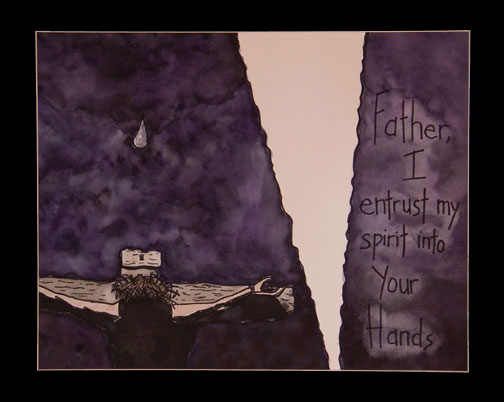
Copyright © Linda Roberts, 2007.
For permission to use this picture, please contact Mark D. Roberts
Luke 23:44-47
44 It was now about noon, and darkness came over the whole land until three in the afternoon, 45 while the sun’s light failed; and the curtain of the temple was torn in two. 46 Then Jesus, crying with a loud voice, said, “Father, into your hands I commend my spirit.” Having said this, he breathed his last. 47 When the centurion saw what had taken place, he praised God and said, “Certainly this man was innocent.”
Reflection
At first glance, Luke’s version of the centurion’s response to Jesus’ death seems like a glaring understatement. “Certainly this man was innocent,” rightly identifies Jesus’s lack of guilt. It makes clear once again the fact that he didn’t deserve to be crucified for sedition against Rome. He was no ordinary revolutionary, no guerrilla warrior, no terrorist. So, yes, “this man was innocent.” But couldn’t Luke have done better than this in his telling of the story? Mark’s version seems so much stronger: “Truly this man was God’s Son!”
We can’t be sure why Luke fashioned the narrative of Jesus’ death as he did. But we can understand that “Certainly this man was innocent” carried more weight with Luke than it might seem. Some translations, including the classic King James, have, “Certainly this was a righteous man” (23:47). This is a literal translation of the Greek, which uses the word dikaios to describe Jesus. Dikaios can mean innocent, but it is the usual word for “righteous,” and the base of such words as “righteousness, justice, justification” (dikaiosyne) and “justify” (dikaioo). From the lips of the centurion comes something far more than a recognition of Jesus’ innocence. It’s an ironic confession of his character as the righteous one, indeed, The Righteous One.
That Jesus was The Righteous One identifies Him with the Suffering Servant from Isaiah 53. In this classic passage we read:
3 He was despised and rejected by others;
a man of suffering and acquainted with infirmity;
and as one from whom others hide their faces
he was despised, and we held him of no account.
4 Surely he has borne our infirmities
and carried our diseases;
yet we accounted him stricken,
struck down by God, and afflicted.
5 But he was wounded for our transgressions,
crushed for our iniquities;
upon him was the punishment that made us whole,
and by his bruises we are healed.
6 All we like sheep have gone astray;
we have all turned to our own way,
and the LORD has laid on him
the iniquity of us all. . . .
11 Out of his anguish he shall see light;
he shall find satisfaction through his knowledge.
The righteous one [ho dikaios], my servant, shall make many righteous,
and he shall bear their iniquities.
12 Therefore I will allot him a portion with the great,
and he shall divide the spoil with the strong;
because he poured out himself to death,
and was numbered with the transgressors;
yet he bore the sin of many,
and made intercession for the transgressors.Isaiah 53:4-6, 11-12
Because Jesus was righteous, because he was innocent, not just of crimes that deserved crucifixion, but of all wrongdoing, therefore he was able to make many righteous by bearing the sin of others. He became the spotless sacrifice for all people.
One of my favorite passages from the New Testament explains in theological language the import of Jesus’s death: “For our sake he made him to be sin who knew no sin, so that in him we might become the righteousness of God” (2 Corinthians 5:21). Simply put, God made Christ to be sin in that he became an offering for sin, taking our place in receiving the death that sin begets. Christ was able to do this because he was The Righteous One. In exchange for his death, we receive his own righteousness (dikaiosyne), the very righteousness of God. Through Christ, we are brought back into right relationship with the living God and begin the process of being made fully right, just like Jesus.
So the apparently simple expression of the centurion, “Certainly this man was innocent” turns out to mean much more than it suggests on the surface. Jesus was not just innocent, but righteous. And he was not just any old righteous person, but The Righteous One who came to fulfill the role of the Suffering Servant. Through his righteous life, and through his sacrificial death, we receive the gift of his own righteousness. What a wonder!
I close today with the wonderful poetry of the classic hymn, “The Solid Rock,” by Edward Mote:
My hope is built on nothing less
Than Jesus’ blood and righteousness;
I dare not trust the sweetest frame,
But wholly lean on Jesus’ name.
On Christ, the solid Rock, I stand;
All other ground is sinking sand,
All other ground is sinking sand.
When darkness seems to hide his face,
I rest on his unchanging grace;
In ev’ry high and stormy gale,
My anchor holds within the veil.
On Christ, the solid Rock, I stand;
All other ground is sinking sand,
All other ground is sinking sand.
His oath, his covenant, his blood
Support me in the whelming flood;
When all around my soul gives way,
He then is all my hope and stay.
On Christ, the solid Rock, I stand;
All other ground is sinking sand,
All other ground is sinking sand.
When he shall come with trumpet sound,
Oh, may I then in him be found;
Dressed in his righteousness alone,
Faultless to stand before the throne.
On Christ, the solid Rock, I stand;
All other ground is sinking sand,
All other ground is sinking sand.
Prayer
Merciful Lord, thank you for being The Righteous One. Thank you for your perfect life and your sacrificial death. Thank you for taking my sin upon yourself, and giving me your righteousness in return.
Like the centurion, I look upon your cross today with wonder. But I’m not only struck by your legal innocence. I’m astounded by your willingness to suffer and die for me, the Righteous One for the unrighteous. All praise be to you, glorious, gracious, giving Lord! Amen.
Topics: Stations of the Cross | 1 Comment »
The Twelfth Station: Jesus on the Cross, His Mother, and His Disciple
By Mark D. Roberts | Thursday, April 9, 2009
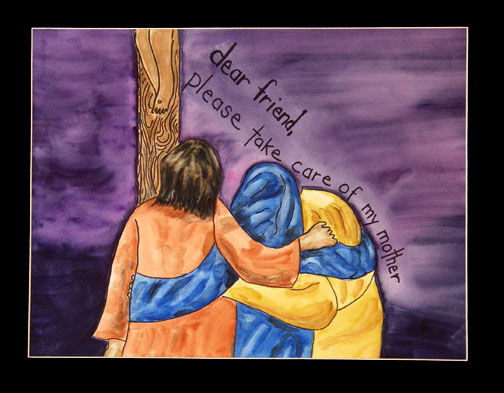 Copyright © Linda Roberts, 2007.
Copyright © Linda Roberts, 2007.
For permission to use this picture, please contact Mark D. Roberts
John 19:25-27
25 Meanwhile, standing near the cross of Jesus were his mother, and his mother’s sister, Mary the wife of Clopas, and Mary Magdalene. 26 When Jesus saw his mother and the disciple whom he loved standing beside her, he said to his mother, “Woman, here is your son.” 27 Then he said to the disciple, “Here is your mother.” And from that hour the disciple took her into his own home.
Reflection
Though most of the men who followed Jesus deserted him at the cross, his female followers remained to observe his death. All four New Testament gospels mention this striking fact (Matt 27:55-56; Mark 15:40-41; Luke 23:49; John 19:25). John alone specifies that Mary the mother of Jesus was among the women who remained near him until the end.
 In the Gospel of John, Mary was standing next to “the disciple whom [Jesus] loved,” believed traditionally to be John, one of Jesus’ closest disciples and the source of the gospel that bears his name. Observing these two, Jesus said to his mother, “Woman, here is your son,” and to the beloved disciple, “Here is your mother” (19:26-27). The writer of the gospel adds, “And from that hour the disciple took her into his own home” (19:27). The basic meaning of Jesus’ statement is clear. He was entrusting care of his mother to one of his most intimate friends and followers. He was making sure that she would be loved and cared for after Jesus’ death. Jesus knew he could trust his beloved follower with an extremely important responsibility. (We don’t know much about the relationship of Jesus and his natural siblings at this point. Earlier in his ministry they seemed to have been less than fully supportive of His ministry [see Mark 3:21]. Later, Jesus’ brother James became one of the main leaders of the Christian church. A piece of Christian tradition holds that, at some later time, Mary accompanied John to Ephesus, where she spent her last days. A few miles outside of Ephesus in modern Turkey is a small house known as The House of the Virgin Mary. Supposedly, this was her last earthly residence. Photo: Mary’s House near Ephesus)
In the Gospel of John, Mary was standing next to “the disciple whom [Jesus] loved,” believed traditionally to be John, one of Jesus’ closest disciples and the source of the gospel that bears his name. Observing these two, Jesus said to his mother, “Woman, here is your son,” and to the beloved disciple, “Here is your mother” (19:26-27). The writer of the gospel adds, “And from that hour the disciple took her into his own home” (19:27). The basic meaning of Jesus’ statement is clear. He was entrusting care of his mother to one of his most intimate friends and followers. He was making sure that she would be loved and cared for after Jesus’ death. Jesus knew he could trust his beloved follower with an extremely important responsibility. (We don’t know much about the relationship of Jesus and his natural siblings at this point. Earlier in his ministry they seemed to have been less than fully supportive of His ministry [see Mark 3:21]. Later, Jesus’ brother James became one of the main leaders of the Christian church. A piece of Christian tradition holds that, at some later time, Mary accompanied John to Ephesus, where she spent her last days. A few miles outside of Ephesus in modern Turkey is a small house known as The House of the Virgin Mary. Supposedly, this was her last earthly residence. Photo: Mary’s House near Ephesus)
Commentators throughout the ages have rightly noticed Jesus’ attention to the needs of others, in this case his mother, even in his hour of excruciating suffering. This is a fine observation and surely fits with everything else we know about Jesus.
But for many years I have been struck by the thought of what Jesus’ mother must have experienced as she watched her son being crucified. I can only begin to imagine her pain. When my father was dying slowly from cancer, his mother (my grandmother) was still alive. Her anguish over her son was palpable. At one point she said to me, “I’d give anything to change places with Dave. No mother should ever have to see her son suffer like this.” I expect Mary could have said similar words as she stood near the cross of Jesus.
Yet Mary might have understood that the death of her son was part of God’s mysterious plan. The Gospels don’t tell us too much about her experience or faith at this time. She surely knew from the very beginning that Jesus was extraordinary and that God had something very special in store for him. And there were moments when she probably understood that Jesus’s destiny would not be an easy one, for him or for her. For example, in Luke 2 when Simeon praised God upon seeing the baby Jesus, he delivered a chilling prophecy to Mary, “This child is destined for the falling and rising of many in Israel . . . and a sword will pierce your own soul too” (2:34-35).
I found Mel Gibson’s portrayal of Mary in The Passion of the Christ extremely moving, partly because he didn’t overplay his hand in depicting Mary’s grief. Though her loving sorrow for her son is obvious, Mary doesn’t weep and wail and carry on. She seems to know that something like this was coming, that Jesus is doing that for which he was born. As a mother, she wants to run to him, and at one point she is able to do so. But she also understands that she cannot rescue Jesus from his fate and that, in a profound sense, she must not even if she could. Jesus has chosen to lay down his life of His own accord, believing that this is the cup his Heavenly Father has given him to drink (John 10:18; Mark 14:32-42). Mary’s strength and reserve seems to respect what her son and, indeed, what his Heavenly Father, have chosen.
As we reflect upon the meaning of Christ’s death this week, Mary’s presence at the cross reminds us of the deeply human drama that is occurring, while it points beyond to the majesty and mystery of God’s plan for salvation.
Prayer
When I think of your mother, Lord, I remember that you weren’t just the Son of God bearing the sins of the world. You were also the son of Mary, the boy whom she loved. Mary gives us a touching reminder of your humanity, Lord. Because you were truly human, because you truly suffered, you did indeed bear the sins of the world, and mine as will. All praise be to you, Lord Jesus! Amen.
Topics: Stations of the Cross | 2 Comments »
The Eleventh Station: Jesus Promises His Kingdom to the Good Thief
By Mark D. Roberts | Wednesday, April 8, 2009
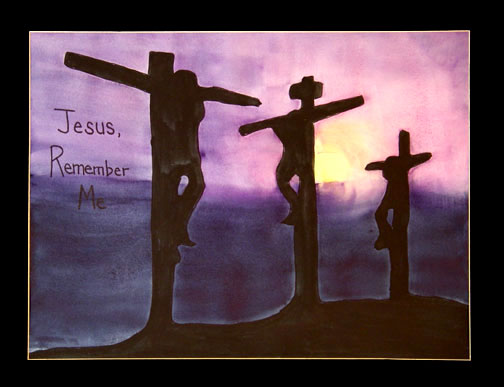
Copyright © Linda Roberts, 2007.
For permission to use this picture and/or others in this series, please contact Mark D. Roberts
Luke 23:39-43
39 One of the criminals who were hanged there kept deriding him and saying, “Are you not the Messiah? Save yourself and us!” 40 But the other rebuked him, saying, “Do you not fear God, since you are under the same sentence of condemnation? 41 And we indeed have been condemned justly, for we are getting what we deserve for our deeds, but this man has done nothing wrong.” 42 Then he said, “Jesus, remember me when you come into your kingdom.” 43 He replied, “Truly I tell you, today you will be with me in Paradise.”
Reflection
Three men being crucified, suffering excruciating pain, literally. (The word “excruciate” comes from the Latin cruciare, “to crucify.”) One man joins the soliders in taunting Jesus, sarcastically calling out for salvation he believes Jesus can’t deliver. The other man, sensing something that he has never felt before, defends Jesus as an innocent victim. Then, in desperate hope, he cries out: “Jesus, remember me when you come into your kingdom.” In response Jesus says a most astounding thing, a most encouraging thing, a most curious thing: “Truly I tell you, today you will be with me in Paradise.”
It’s easy to imagine the jeers of the soldiers at this point as they made fun of Jesus’ silly wishful thinking. After all, he’d only been on the cross for an hour or two. Most crucifixions lasted several days before the victim finally died from exhaustion, exposure, loss of blood, and suffocation. Today in Paradise? What a joke! All Jesus and the stooge beside him would experience that day was ultimate pain and ultimate disgrace. If they were lucky, perhaps tomorrow they might die. And even then, Paradise? Hardly!
The word “Paradise” comes from a Persian word meaning “garden.” It was used to describe a place of beauty, peace, and joy. In Jewish thought, Paradise represented the Garden of Eden, and could stand for the joys of heaven. Paradise was just about as far as one could get from crucifixion. Yet, in spite of the apparent absurdity, and in spite of the spiteful laughter of the hostile onlookers, Jesus promised that the thief would join him in Paradise even the day of their crucifixion.
Luke 23:39-43 has often perplexed Christians who believe that salvation comes only by explicitly confessing Jesus as Savior and Lord. “Jesus, remember me when you come into your kingdom” hardly fits the bill here. Whatever the desperate thief believed about Jesus, it’s unlikely that he prayed the sinner’s prayer while on his cross. And we have no reason to believe that Jesus straightened out the thief’s theology before offering the promise of Paradise. No, what we have in the text of Luke is a cry of minimal faith and maximal desperation. And what we have from the mouth of Jesus is a response of extraordinary mercy.
It would be unwise to build a whole theology of salvation on the basis of this single passage from Luke. And it would be unwise to build a theology of salvation without taking seriously this passage. Whatever else, it reminds us that God is “rich in mercy” (Ephesians 2:4). God saves us, not because we earn it, not because we deserve it, not becuase we say the right words and pray the right prayers, and not even because we get our theology right, but because God is full of mercy, mercy revealed and poured out through Jesus Christ, mercy that says to a thief: “Today you will be with me in Paradise.”
If this crucified criminal could have hope, then perhaps you and I can as well. We hope, not in our goodness, not in our good intentions, but in the matchless mercy of God. As I reflect on Jesus’ response to the thief, I’m reminded of a marvelous hymn by Frederick William Faber, “There’s a Wideness in God’s Mercy.” It turns out that this hymn is actually an excerpt from a longer piece written by Faber, called “Souls of Men! Why Will Ye Scatter.” I’ll close today with all of Faber’s verses:
Souls of men, why will ye scatter
like a crowd of frightened sheep?
Foolish hearts, why will ye wander
from a love so true and deep?
Was there ever kindest shepherd
half so gentle, half so sweet,
as the Savior who would have us
come and gather round his feet?There’s a wideness in God’s mercy,
like the wideness of the sea;
there’s a kindness in his justice,
which is more than liberty.
There is no place where earth’s sorrows
are more felt than up in heaven;
there is no place where earth’s failings
have such kindly judgment given.There is welcome for the sinner,
and more graces for the good;
there is mercy with the Savior;
there is healing in his blood.
There is plentiful redemption
in the blood that has been shed;
there is joy for all the members
in the sorrows of the Head.For the love of God is broader
than the measure of man’s mind.
and the heart of the Eternal
is most wonderfully kind.
But we make his love too narrow
by false limits of our own;
and we magnify its strictness
with a zeal he will not own.Pining souls, come nearer Jesus,
and O come not doubting thus,
but with faith that trusts more bravely
his great tenderness for us.
If our love were but more simple,
we should take him at his word:
and our lives would be all sunshine
in the sweetness of our Lord.
Prayer
Dear Lord, how I thank and praise you for your mercy. You give us, not what we deserve, but infinitely better. Thank you for hearing my cries to you, and for responding to me much as you did to the thief who sought your help. Thank you for remembering even me, and for the promise I have of Paradise beyond this life. There’s much I don’t understand about the afterlife, but what I know is that I will be with you, seeing you face to face. And in your presence there will be fullness of joy. That’s more than enough for me! Amen.
Topics: Stations of the Cross | 2 Comments »
The Tenth Station: Jesus is Crucified
By Mark D. Roberts | Tuesday, April 7, 2009

Copyright © Linda Roberts, 2007.
For permission to use this picture and/or others in this series, please contact Mark D. Roberts
Luke 23:33-4, 47
23:33 When they came to the place that is called The Skull, they crucified Jesus there with the criminals, one on his right and one on his left. Then Jesus said, “Father, forgive them; for they do not know what they are doing.” And they cast lots to divide his clothing.
23:47 When the centurion saw what had taken place, he praised God and said, “Certainly this man was innocent.”
Reflection
 According to Luke, Jesus was crucified at “the place that is called The Skull” (23:33). The other Gospels mention that it was called Golgotha, the Greek transliteration of the Aramaic word Gûlgaltâ that means “skull.” We get the English word “Calvary” by way of the Latin calvariae locum, which means, “place of the skull.” (Photo: The Church of the Resurrection in Jerusalem. Golgotha is believed to be under the large dome.)
According to Luke, Jesus was crucified at “the place that is called The Skull” (23:33). The other Gospels mention that it was called Golgotha, the Greek transliteration of the Aramaic word Gûlgaltâ that means “skull.” We get the English word “Calvary” by way of the Latin calvariae locum, which means, “place of the skull.” (Photo: The Church of the Resurrection in Jerusalem. Golgotha is believed to be under the large dome.)
 The precise location of Golgotha is not clear from Scripture. It was near Jerusalem according to John 19:20, and therefore, by implication, not in the ancient city proper. Hebrews 13:12 mentions that Jesus “suffered outside the city gate.” John 19:41 adds that there was a garden in the place where Jesus was crucified. (Photo: Inside the Church of the Resurrection. The actual place of Jesus’ crucifixion is on the left side of the photo.)
The precise location of Golgotha is not clear from Scripture. It was near Jerusalem according to John 19:20, and therefore, by implication, not in the ancient city proper. Hebrews 13:12 mentions that Jesus “suffered outside the city gate.” John 19:41 adds that there was a garden in the place where Jesus was crucified. (Photo: Inside the Church of the Resurrection. The actual place of Jesus’ crucifixion is on the left side of the photo.)
From the earliest days, Christian tradition has identified the location of Golgotha in a place that is now within an ancient church in Jerusalem (the Anastasis Chuch, or Church of the Resurrection, also called the Basilica of the Holy Sepulchre). This church is now located near the center of Jerusalem. But in the first century this location was actually outside of the walls of the city.
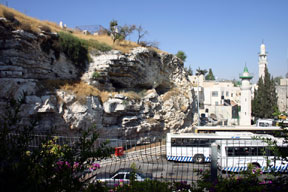 Modern archeology has substantially confirmed the accuracy of traditional Christian belief about the location of Golgotha (Note 1). Since the nineteenth century, an alternative location for Jesus’s crucifixion has been popular. The so-called Gordon’s Calvary (near the Garden Tomb) does look somewhat like a skull, but most scholars don’t believe it was the location of Jesus’s death for a variety of sensible reasons. (Photo: Gordon’s Calvary does look a bit like a skull, but Golgotha probably got its name, not from this rock formation, but from the fact that so many people were crucified there. These photos are all from Holy Land Photos, a fantastic source of pictures. Used by permission.)
Modern archeology has substantially confirmed the accuracy of traditional Christian belief about the location of Golgotha (Note 1). Since the nineteenth century, an alternative location for Jesus’s crucifixion has been popular. The so-called Gordon’s Calvary (near the Garden Tomb) does look somewhat like a skull, but most scholars don’t believe it was the location of Jesus’s death for a variety of sensible reasons. (Photo: Gordon’s Calvary does look a bit like a skull, but Golgotha probably got its name, not from this rock formation, but from the fact that so many people were crucified there. These photos are all from Holy Land Photos, a fantastic source of pictures. Used by permission.)
Christians throughout the ages have made pilgrimages to Golgotha, walking along the Via Dolorosa and pausing to remember the Stations of the Cross along the way. Since I’ve never been to Jerusalem, I’ve not yet had the chance to visit the place where Jesus died. I hope to do so at some point in my life.
Why? Why would I join the millions of Christians who have made a pilgrimage to Golgotha?
There’s something about being in the actual place where something momentous happened that makes the event more real. When I was in college, I used to ride my bike to Concord, Massachusetts, to the North Bridge, the place where “the shot heard round the world” began the War for Independence in 1775. As I leaned on that bridge and looked upon the peaceful countryside, I’d think about the men who died that day, and about the freedom I enjoy because of their sacrifice. I’d leave Concord with deeper gratitude for blessings I usually take for granted.
Sadly, I also can take the freedom I have in Christ for granted. For over four decades, I’ve known that Jesus died for my sins. And, even though I’ve staked my life upon this good news, there are times when it can almost seem old hat. I expect that a visit to Golgotha, like to the Concord bridge, would retool my perspective. I’d remember that the death of Jesus really happened, in a real place at a real time. There the Lord of Glory suffered and died for the sins of the world . . . and for my own sins. I yearn to experience the truth of Jesus’ death more profoundly and thus I hope to visit Golgotha someday.
In the meanwhile, I’m thankful for the Stations of the Cross that allow us to approximate a pilgrimage to Calvary. The images and verses of the Via Crucis invite us to follow Jesus to the cross, that we might experience deeper gratitude for the blessings we can so easily take for granted.
Prayer
Gracious Lord, how can I ever thank you for dying on the cross for me? Your death has given me life. Your sacrifice has led to my blessing. Yet I confess that I can sometimes take your death for granted, forgetting what you did for me and neglecting its significance. Forgive me, Lord. And even though I can’t go to the actual place of your crucifixion today, may the reality of your sacrifice press itself upon my mind and flood my heart.
All praise to you, merciful Lord, for Your cross!
Notes:I have found three fairly helpful online discussions of the location of Golgotha: “Mt. Calvary” in The Catholic Encyclopedia, “Calvary” of Wikipedia, and “Where Was Golgotha?” from the Worldwide Church of God website.
Topics: Stations of the Cross | No Comments »
The Ninth Station: Jesus Meets the Women of Jerusalem
By Mark D. Roberts | Monday, April 6, 2009

Copyright © Linda Roberts, 2007.
For permission to use this picture and/or others in this series, please contact Mark D. Roberts
Luke 23:27-31
27 A great number of the people followed him, and among them were women who were beating their breasts and wailing for him. 28 But Jesus turned to them and said, “Daughters of Jerusalem, do not weep for me, but weep for yourselves and for your children. 29 For the days are surely coming when they will say, ‘Blessed are the barren, and the wombs that never bore, and the breasts that never nursed.’ 30 Then they will begin to say to the mountains, ‘Fall on us’; and to the hills, ‘Cover us.’ 31 For if they do this when the wood is green, what will happen when it is dry?”
Reflection
Growing up, I pictured the last week of Jesus’s life in stark, simple terms. Jerusalem, in my imagination, no doubt colored by Sunday school film strips, was a small town of maybe a few hundreds residents. All of these people came out to hail Jesus as king on Palm Sunday. Then, all of these same people showed up at Pilate’s palace to call for his crucifixion. Though I wasn’t a hardcore anti-Semite, I believed that “the Jews” wanted Jesus dead because he had claimed to be God.
Whenever I pictured Jesus meeting the women of Jerusalem along the Via Dolorosa, there were just two or three women, no doubt followers of Jesus, who were weeping for him. Meanwhile, the rest of the Jewish crowd was egging on the Roman soldiers, eager to see Jesus crucified. The Jews wanted Jesus dead. Right?
Wrong, actually. A few years ago I began to study the New Testament records of Jesus’ death with greater care. To my surprise, I saw things I had completely overlooked before, things that changed my perception of Jesus’ last hours.
For example, Luke 23:27 notes that “a great number of people followed [Jesus]” as he walked to Golgotha. Luke gives no indication that they were crying out for Jesus’ death. In fact, by mentioning the women weeping for Jesus, Luke implies that the “great number of the people” were upset by what was happening to him. There’s no evidence that that were egging on the Roman soldiers, as I once imagined. (In fact, this “egging on” scenario I had imagined makes no sense in light of the unpopularity of Rome among first-century Jews, especially Roman soldiers.)
Luke makes this even clearer a few verses later, after Jesus’ death: “And when all the crowds who had gathered there for this spectacle saw what had taken place, they returned home, beating their breasts” (Luke 23:48). Since was a physical sign of extreme grief, Luke shows us that the great majority of Jews who had witnessed Jesus’ crucifixion were horrified, not happy, to see him die. They were certainly not among those who had earlier called for his crucifixion in Pilate’s courtyard.
The fact that only a small minority of Jews in Jerusalem actually wanted Jesus to be killed is confirmed by another passage in the Gospels that I had once overlooked. In Matthew, as Jesus is teaching in the temple during the days before his death, we read:
When the chief priests and the Pharisees heard his parables, they realized that he was speaking about them. They wanted to arrest him, but they feared the crowds, because they regarded him as a prophet. (Matthew 21:45-46)
The Jewish leaders wanted to arrest Jesus, but “they feared the crowds.” Why? Because the crowds “regarded him as a prophet” and, by implication, would have been horrified to see him arrested and crucified.
My close reading of the Gospels, combined with study of first-century Jewish history and culture, has corrected my youthful misunderstandings. I now realize that Jerusalem wasn’t a small village, but a substantial city of perhaps 30,000 or more residents. During the Jewish holidays, such as Passover, the population would swell to as much as ten times this amount. This means that a tiny percentage of the Jews in Jerusalem were directly involved with or actually called for the crucifixion of Jesus. His death was surely engineered by the Jewish leaders in collusion with Pilate and his Roman cohort. As far as we know, the vast majority of Jews in Jerusalem were either horrified by or unaware of what was going on with Jesus.
I think it’s important for us to understand what really happened in the death of Jesus for a number of reasons, not the least of which is the sad history of anti-Semitism among Christians. For too long it was acceptable to utter the familiar refrain, “The Jews killed Christ.” And for too long, many Christians used this as an excuse to persecute Jews who lived centuries after the death of Jesus, and who therefore had nothing to do with his death. In fact, some Jews were involved in the death of Jesus, mostly the leaders of Jerusalem. But Pontius Pilate alone had the authority to crucify Jesus. According to the Gospels, the majority of Jews who had any awareness of Jesus’ death were grieved, not glad. If we blame “the Jews” for the death of Christ, we’re making an historical mistake. If we hold contemporary Jews liable for the death of Jesus, we’re compounding the error.
And, of course, we’re also missing the main point. Jesus did not die primarily as a helpless victim of Roman or Jewish injustice. He chose to die on the cross in faithfulness to the Father’s will so that he might bear the sin of the world. If anyone is to blame for the death of Jesus, we are, because we have sinned. Thus in looking upon Jesus’s death, we join the women of Jerusalem in weeping, not only for Jesus, but also for ourselves. In the death of Jesus we see what we deserve, and we rightly feel appalled.
Then the mystery of grace astounds us. We realize that Jesus is bearing our sin so that we might be forgiven, that he is dying in our place so that we might live in his place. We sense the mystery expressed in 2 Corinthians 5:21: “For our sake [God] made [Christ] to be sin who knew no sin, so that in him we might because the righteousness of God.” What a wonder!
Prayer
Dear Lord, to whatever extent there are remnants of anti-Semitism in me, please forgive me and cleanse my mind and heart. Help me not to blame others for the death of Jesus, but to see my own sin as sending him to the cross. Even more, help me to grasp the mystery of your grace, to see in the death of Jesus that which gives me life. May my weeping over the suffering of Jesus, and my sorrow over my own sin, turn to joy when I recognize the majesty of your mercy. Amen.
Topics: Stations of the Cross | No Comments »
The Eighth Station: Simon of Cyrene Helps Jesus to Carry His Cross
By Mark D. Roberts | Sunday, April 5, 2009

Copyright © Linda Roberts, 2007.
For permission to use this picture and/or others in this series, please contact Mark D. Roberts
Luke 23:26
As they led him away, they seized a man, Simon of Cyrene, who was coming from the country, and they laid the cross on him, and made him carry it behind Jesus.
Reflection
What a shock this must have been for Simon! After traveling almost a thousand miles from Cyrene in northern Africa to Jerusalem (Note 1), he found the city jammed with pilgrims who, like Simon himself, had come to celebrate the Passover in Jerusalem. So Simon set up camp out in the countryside. On his way into the city, he stumbled into what might have looked from a distance like a parade. But then, as he drew near, Simon saw the horrific spectacle of a badly beaten man stumbling as he was forced to carry the beam of his cross on the way to being crucified. We don’t know for sure whether Simon had any knowledge of Jesus prior to their encounter on the road to Golgotha. It’s likely that he knew nothing about the suffering man before him.
As Simon watched in horror, all of a sudden he found himself pressed into action. The Roman soldiers, recognizing that Jesus didn’t have sufficient strength to carry his cross by himself, “seized” Simon and demanded that he carry the cross instead. No doubt Simon was hesitant, fearing that he might end up sharing Jesus’s fate. Yet he knew enough not to provoke the soldiers, so he took the cross as ordered. We don’t know much more about Simon than this, since he disappears from the biblical record at this point (Note 2).
Although Simon only helped to carry the cross of Jesus and was not actually crucified, he nevertheless illustrates the theological truth found in the letters of Paul in the New Testament. In the letter to the Galatians we read:
I have been crucified with Christ; and it is no longer I who live, but it is Christ who lives in me. And the life I now live in the flesh I live by faith in the Son of God, who loved me and gave himself for me. (Galatians 2:19-20)
The letter to the Romans contains even more detail about what it means to be crucified with Christ:
What then are we to say? Should we continue in sin in order that grace may abound? By no means! How can we who died to sin go on living in it? Do you not know that all of us who have been baptized into Christ Jesus were baptized into his death? Therefore we have been buried with him by baptism into death, so that, just as Christ was raised from the dead by the glory of the Father, so we too might walk in newness of life. For if we have been united with him in a death like his, we will certainly be united with him in a resurrection like his. We know that our old self was crucified with him so that the body of sin might be destroyed, and we might no longer be enslaved to sin. For whoever has died is freed from sin. But if we have died with Christ, we believe that we will also live with him. We know that Christ, being raised from the dead, will never die again; death no longer has dominion over him. The death he died, he died to sin, once for all; but the life he lives, he lives to God. So you also must consider yourselves dead to sin and alive to God in Christ Jesus. (Romans 6:1-11)
When we put our faith in Christ, we shared in his death, not by literally dying, but by dying to sin. Our “old self” was crucified so that we might be set free from our bondage to sin. Now we are alive in Christ, who lives in us.
Thus, in a sense, we ought to identify with Simon of Cyrene, who found himself a surprised participant in the crucifixion of Christ. This is especially true since many of us became Christians without really knowing that we were dying to our old selves so that we might live anew in Christ. We were pitched a gospel of salvation and eternal life without the corollary call to servanthood, sacrifice, and death to sin and self. Thus it was only later in our Christian pilgrimage when we discovered, like Simon, that we were expected to be “crucified with Christ.”
Unlike Simon, however, we aren’t forced to pick up the cross of Christ. Jesus invites us to follow him, but even though he is our Lord, he doesn’t force us against our will to join him. Rather, he beckons to us, calling us to take up our cross and offering abundant life in return. As he said earlier in Luke’s Gospel:
“If any want to become my followers, let them deny themselves and take up their cross daily and follow me. For those who want to save their life will lose it, and those who lose their life for my sake will save it. (Luke 9:23-24)
If we take up the cross of Christ, we will lose our lives, only to discover that we have found true life in him.
Prayer
Dear Lord, the powerful example of Simon reminds me that I am also to take up the cross and follow you. You have called me to die to myself so that I might live for you. I confess that sometimes I resist this call, even though I know that in dying to myself I find true life in you. So help me, Lord, to carry my cross, to give my life away so that I might receive the abundant life of your kingdom.
I could not do this were in not for the fundamental fact that you took my place on the cross. Through you, I am forgiven and invited into the fullness of life. In your death, I am raised to new life. All thanks and praise be to you, Lord Jesus, for bearing my sin on the cross, so that I might bear the cross into eternal life, both now and forever. Amen.
Notes:
Note 1: Cyrene is in northern Africa, where Libya is today.
Note 2: Mark names Simon’s sons as Alexander and Rufus, presumably because these men were known to the community for whom Mark was writing (Rome? see Mark 15:21). Paul also mentions a Rufus in the close of his letter to the Romans (Romans 16:13). He might be the son of Simon, but this is only speculation. Some second-century Gnostics argued that it wasn’t Jesus who died on the cross, but Simon of Cyrene. There’s no basis for this in reliable historical texts. Some Muslims also hold this view, since they deny that Jesus died on the cross. (See this Muslim explanation at IslamOnline.net.) Because of Simon’s north African origin, some have thought he might have been a black man. While this is possible, it is by no means certain. Yet it’s surely more likely that Simon was of darker complexion than he is sometimes pictured in traditional images.
Topics: Stations of the Cross | No Comments »
The Seventh Station: Jesus Takes Up the Cross
By Mark D. Roberts | Saturday, April 4, 2009

Copyright © Linda Roberts, 2007.
For permission to use this picture and/or others in this series, please contact Mark D. Roberts
Mark 15:20
After mocking him, they stripped him of the purple cloak and put his own clothes on him. Then they led him out to crucify him.
Reflection
Jesus had said this would happen. For quite some time he had predicted his suffering and death. The first time came right after Peter confessed him to be the Messiah. Jesus responded: “The Son of Man must undergo great suffering, and be rejected by the elders, chief priests, and scribes, and be killed, and on the third day be raised” (Luke 9:22). So even though the Roman soldiers led Jesus out to crucify him, they were only doing what he had said they would do.
Indeed, they were doing what he chose to happen and in many ways caused to happen. After all, Jesus had been preaching that God along was the true King, and that his kingdom was at hand . . . not exactly the kind of message Rome liked to hear. And Jesus had been in regular conflict with Jewish leaders, who saw him as a nuisance and a threat. Then, he stirred up the crowds by riding into Jerusalem as a messianic king. He disturbed the Jewish officials by ransacking the temple and halting its sacrifices, accusing the temple leaders of being no better than a bunch of thieves. Jesus seemed even to know that Judas was planning to betray him, and Jesus appeared to consent to the betrayal. Jesus did not defend himself before the Sanhedrin, perhaps because he knew this was a lost cause. But he didn’t try to set Pilate straight either. And, of course, Jesus did not call down legions of angels to deliver him.
So, though “they led him out to crucify him,” Jesus was no passive victim. He picked up his cross and walked to Golgotha because he had chosen the way of suffering. He believed this to be the will of God, the way by which he would realize his messianic destiny. Jesus chose to suffer and die so that he might fulfill Isaiah’s vision of the Suffering Servant of God, the one who was “despised and rejected by others; a man of suffering and acquainted with infirmity.” As this Servant, Jesus “has borne our infirmities and carried our diseases.” Moreover, “he was wounded for our transgressions, crushed for our iniquities; upon him was the punishment that made us whole, and by his bruises we are healed” (Isaiah 53:3-5).
Prayer
Dear Lord, you chose the cross. Yes, the Jewish leaders accused you. And, yes, Pilate sentenced you. And, indeed, Roman soldiers led you to Golgotha. But in a very real sense they were simply working out what God had willed and you had freely and painfully chosen.
How I thank you for this costly choice! Because you took up the cross, I can take up life in all of its fullness. Because you were led to die, I can be led into the eternal life. Because you bore my sin, I can enjoy your forgiveness. How good you are to me, dear Lord, my Savior!
Topics: Stations of the Cross | No Comments »
The Sixth Station: Jesus is Scourged and Crowned with Thorns
By Mark D. Roberts | Friday, April 3, 2009

Copyright © Linda Roberts, 2007.
For permission to use this picture and/or others in this series, please contact Mark D. Roberts
Luke 22:63-65; John 19:2-3
Luke 22:63 Now the men who were holding Jesus began to mock him and beat him; 64 they also blindfolded him and kept asking him, “Prophesy! Who is it that struck you?” 65 They kept heaping many other insults on him.
John 19:2 And the soldiers wove a crown of thorns and put it on his head, and they dressed him in a purple robe. 3 They kept coming up to him, saying, “Hail, King of the Jews!” and striking him on the face.
Reflection
What cruel irony! Jesus finally received the words he deserved: “Hail, King of the Jews!” For once he wore a crown upon his head. But it was not the golden crown of sovereignty or the olive crown of victory, but the thorny crown of suffering. Scholars have shown that the thorns from which Jesus’ crown was composed were long and terribly sharp. No doubt they dug deep into the head of the suffering king. We can’t really imagine the physical pain, not to mention the emotional and spiritual anguish, endured by the King of kings.
What incomprehensible irony! Jesus, the true king of Israel, endured the pain and mockery of the crown of thorns as part of his humiliation for us and our salvation. What was the result of his torture? Paul puts it this way in Philippians 2:5-11:
Let the same mind be in you that was in Christ Jesus,
who, though he was in the form of God,
did not regard equality with God
as something to be exploited,
but emptied himself,
taking the form of a slave,
being born in human likeness.
And being found in human form,
he humbled himself
and became obedient to the point of death—
even death on a cross.
Therefore God also highly exalted him
and gave him the name
that is above every name,
so that at the name of Jesus
every knee should bend,
in heaven and on earth and under the earth,
and every tongue should confess
that Jesus Christ is Lord,
to the glory of God the Father.
Did you catch that? Because Jesus humbled himself, because He endured the humiliation of the cross, including the crown of thorns, therefore God exalted him to the highest place. For Jesus, the path to glory as King of kings included the path of disgrace. Because he wore the crown of thorns, Jesus would receive the crown of universal worship.
One of my favorite hymns is “Crown Him with Many Crowns.” It is a celebration of the multi-faceted sovereignty of Christ. Curiously, however, even in its full, original nine verses, this fine hymn doesn’t mention Jesus’ crown of thorns, though it does refer to his death in several different ways, mentioning specifically his “pierced feet” and his wounded “hands and side.” I’d like to close today’s reflection by printing the most popular four verses of “Crown Him with Many Crowns.” I’ve added a new verse, which you’ll find in italics:
Crown Him with Many Crowns
By: Matthew Bridges and Godfrey Thring
(Added verse by Mark D. Roberts)Crown him with many crowns,
The Lamb upon his throne;
Hark! how the heav’nly anthem drowns
All music but its own:
Awake, my soul, and sing
Of him who died for thee,
And hail him as thy matchless King
Thro’ all eternity.Crown Him the promised One,
Messiah, Israel’s king,
Who walked in servanthood along,
The path of suffering.
His honor struck in shame,
A brutal crown adorns,
His head bowed in humility,
Enhanced with twisted thorns.Crown him the Lord of life,
Who triumphed o’er the grave,
And rose victorious in the strife
For those he came to save;
His glories now we sing
Who died, and rose on high,
Who died eternal life to bring,
And lives that death may die.Crown him the Lord of peace,
Whose pow’r a scepter sways
From pole to pole, that wars may cease,
And all be pray’r and praise:
His reign shall know no end,
And round his pierced feet
Fair flow’rs of paradise extend
Their fragrance ever sweet.Crown him the Lord of love;
Behold his hands and side,
Those wounds, yet visible above,
In beauty glorified:
All hail, Redeemer, hail!
For thou hast died for me:
Thy praise and glory shall not fail
Thro’out eternity.
Prayer
Gracious, merciful Lord, how hard it is to read of the abuse you suffered even prior to your crucifixion. I can’t even begin to imagine what you felt, not only physically, but especially in your soul. What can I say in response but “thank you” for walking the path of suffering and shame for my sake. You took the abuse that I deserved, and gave me your glory in return.
Help me, dear Lord, to honor you as my King in all that I do. May my words and deeds reflect your sovereignty and celebrate your glory.
Amen.
Topics: Stations of the Cross | 4 Comments »
The Fifth Station: Jesus is Judged by Pilate
By Mark D. Roberts | Thursday, April 2, 2009
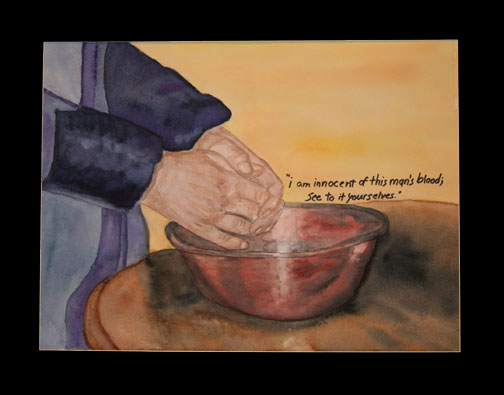
Copyright © Linda Roberts, 2007.
For permission to use this picture and/or others in this series, please contact Mark D. Roberts
Luke 23:13-25
13 Pilate then called together the chief priests, the leaders, and the people, 14 and said to them, “You brought me this man as one who was perverting the people; and here I have examined him in your presence and have not found this man guilty of any of your charges against him. 15 Neither has Herod, for he sent him back to us. Indeed, he has done nothing to deserve death. 16 I will therefore have him flogged and release him.”
18 Then they all shouted out together, “Away with this fellow! Release Barabbas for us!” 19 (This was a man who had been put in prison for an insurrection that had taken place in the city, and for murder.) 20 Pilate, wanting to release Jesus, addressed them again; 21 but they kept shouting, “Crucify, crucify him!” 22 A third time he said to them, “Why, what evil has he done? I have found in him no ground for the sentence of death; I will therefore have him flogged and then release him.” 23 But they kept urgently demanding with loud shouts that he should be crucified; and their voices prevailed. 24 So Pilate gave his verdict that their demand should be granted. 25 He released the man they asked for, the one who had been put in prison for insurrection and murder, and he handed Jesus over as they wished.
Reflection
There has been a tendency in the Christian telling of the Passion story to exonerate Pilate, or at least to make him an unwilling pawn of the Jewish leaders and crowds. Pilate, it is claimed, was a truth-seeking man who was caught between a rock and a hard place. Were it not for the pressure he received from the Sanhedrin and their supporters, he wouldn’t have crucified Jesus.
This view of the noble Pilate seems at first to fit the facts of the New Testament Gospels. But, upon closer scrutiny, it falls short in a number of crucial ways.
First, it overlooks Pilate’s record of cruelty in his dealings with the Jewish people. Far from being some benevolent ruler, Pilate frequently offended and grieviously mistreated those he was sent to govern. The Jewish historian Josephus records an instance when Pilate used money given to the Jerusalem temple for one of his pet projects. When a crowd of Jews objected, Pilate killed a great number of them (Antiquities 18.3.2). The Gospel of Luke records a similar instance when Pilate killed a number of Galilean Jews, mingling their blood with their temple sacrifices (Luke 13:1). The first-century Jewish philosopher, Philo of Alexandria, once wrote a letter to Caesar, in which, among other things, he blamed Pilate for: “briberies, insults, robberies, outrages, wanton injustices, constantly repeated executions without trial, and ceaseless and grievous cruelty.” (Legatio ad Gaium, 301-302). (Photo: An inscription found in Caesarea Maritima in Israel which mentions Pontius Pilate and identifies him as the “Prefect of Judea.”)
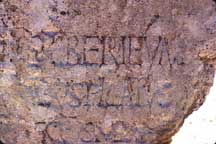 Second, it’s unlikely that Pilate would have been forced to act contrary to his will by the Jewish leaders and the crowd they rounded up to call for the crucifixion of Jesus. Pilate was surely aware of Jesus’ widespread popularity among the Jewish people. This, in fact, would have been a major concern to him, especially during the Passover, when the normal population of Jerusalem (around 35,000) swelled to perhaps ten times that amount. In other words, if Pilate had wanted to keep Jesus alive, he surely could have “gone over the heads” of the Jewish leaders to the large group of Jesus’s supporters and admirers. Of course Pilate didn’t need anyone’s approval to have Jesus killed. He had the authority to order execution. But Pilate was no doubt concerned about whether such an action in the case of Jesus would lead to revolt. So, we have every reason to believe that Pilate in fact wanted Jesus to be crucified, otherwise he would not have sentenced Him to death.
Second, it’s unlikely that Pilate would have been forced to act contrary to his will by the Jewish leaders and the crowd they rounded up to call for the crucifixion of Jesus. Pilate was surely aware of Jesus’ widespread popularity among the Jewish people. This, in fact, would have been a major concern to him, especially during the Passover, when the normal population of Jerusalem (around 35,000) swelled to perhaps ten times that amount. In other words, if Pilate had wanted to keep Jesus alive, he surely could have “gone over the heads” of the Jewish leaders to the large group of Jesus’s supporters and admirers. Of course Pilate didn’t need anyone’s approval to have Jesus killed. He had the authority to order execution. But Pilate was no doubt concerned about whether such an action in the case of Jesus would lead to revolt. So, we have every reason to believe that Pilate in fact wanted Jesus to be crucified, otherwise he would not have sentenced Him to death.
Third, what we see in the Gospels is, in all likelihood, a carefully scripted plot by Pilate. Knowing how popular Jesus was among the masses, Pilate knew he faced the possibility of insurrection if he himself was believed to be responsible for the death of Jesus. So he had to find a way to use his authority to crucify Jesus, and, at the same time, to publicly wash his hands of this decision. Thus he cleverly toyed with the Jewish leaders and their supporters, until it appeared as if he was compelled against his will to have Jesus crucified. Thus Pilate could get rid of Jesus and, at the same time, insure that popular anger would be directed at Jewish leaders and not at himself and Rome.
In another place I have written this about Pilate and his decision to have Jesus crucified:
The fact that Pilate had Jesus crucified strongly suggests that he saw Jesus as a threat to Roman order. Though not your ordinary brigand or revolutionary, Jesus proclaimed the kingdom of God (not Caesar) and accepted adulation as a messianic (kingly) figure. Moreover, even if his answers to Pilate were minimal, Jesus didn’t reject the charge that he claimed to be king of the Jews. So, even though Jesus wasn’t your run-of-the-mill Zealot, he was still the sort of person who was dangerous to Rome, and was therefore worthy of death, at least from the Roman point of view.
Why have I taken time to establish Pilate’s actual guilt for the death of Jesus? For one thing, this is an important antidote to the a-historical and anti-Semitic tendency among some Christians to exonerate Pilate and blame “the Jews” in general for the death of Jesus. To be sure, most (but not all) of the Jewish leaders in Jerusalem wanted Jesus killed and plotted to that end. But the Gospels bear witness to the popularity of Jesus among common Jewish people (for example, Matt 4:25; 8:1; 9:8; 12:15; 13:2; 14:14; 15:30; 20:29; 21:8). Thus, Pilate must not be excused for his central role in the death of Jesus. He alone had the authority in Jerusalem to sentence Jesus to death by crucifixion, and he must bear this guilt.
I have focused on Pilate for another reason as well. I see him as a paradigm of the person who fails to take responsibility for his or her actions. Perhaps Pilate really believed he was innocent of Jesus’ death. Perhaps, as I have suggested, he was playacting for his own political benefit. Either way, Pilate issued the verdict that sent Jesus to the cross. Yet he did so in such a way as to appear innocent of Jesus’s blood. He did not take responsibility for what he had done.
How often do we do this sort of thing ourselves? How often do we rationalize our sins, blaming them on others? How often to we fail to take responsibility for what we have done wrong, preferring to assign credit to our parents for raising us wrongly, our society for mistreating us, our boss for abusing us, our spouse for misunderstanding us? I can’t tell you how many times, as a pastor, I have heard people try to evade responsibility for their own sins by pointing to the sins of others. And, if truth be told, I’ve done plenty of this myself.
Why is this wrong? Well, for one thing it’s dishonest. Yet, beyond this, when we fail to accept responsibility for our sins, then we lose the opportunity to experience forgiveness for them. If I’m blaming others when I do wrong, then surely I won’t confess what I’ve done as sin. And this, in turn, will keep me from experiencing the grace of God with respect to this particular sin. (I’m not saying this will keep me out of Heaven, but rather that I will fail to enjoy the fulness of God’s forgiveness in this life.)
When we’re tempted to be like Pilate, we’d do well to remember a portion of the first letter of John in the New Testament:
If we say that we have no sin, we deceive ourselves, and the truth is not in us. If we confess our sins, he who is faithful and just will forgive us our sins and cleanse us from all unrighteousness. If we say that we have not sinned, we make him a liar, and his word is not in us. (1 John 1:8-10)
As you look at your life, don’t be like Pilate. Don’t try to wash your hands of that which you have done wrong. God isn’t fooled. Rather, tell God the truth about your sins so that you might experience His forgiveness through Christ.
Prayer
Dear Lord, You know how easy it is for me to be like Pilate. I don’t like to take responsibility for my failures. I find rationalization to be so natural. I can fool myself into thinking I haven’t really done wrong.
So forgive me, Lord, when I follow the way of Pilate. Help me to acknowledge my sins, both to myself and to you, rather than wallowing in my pointless excuses and defenses. By your Spirit, guide me to see clearly where I have missed your mark, so that I might confess truly and fully. Help me to experience the forgiveness you offer in Christ, and to live in the freedom of the cleansing you alone provide.
Amen.
Topics: Stations of the Cross | 4 Comments »
The Fourth Station: Peter Denies Jesus
By Mark D. Roberts | Wednesday, April 1, 2009
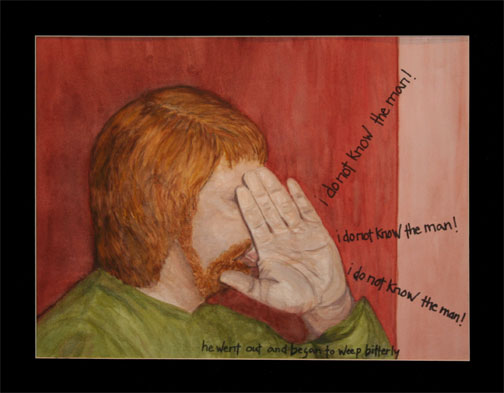
Copyright © Linda Roberts, 2007.
For permission to use this picture and/or others in this series, please contact Mark D. Roberts
Luke 22:54-62
54 Then they seized him and led him away, bringing him into the high priest’s house. But Peter was following at a distance. 55 When they had kindled a fire in the middle of the courtyard and sat down together, Peter sat among them. 56 Then a servant-girl, seeing him in the firelight, stared at him and said, “This man also was with him.” 57 But he denied it, saying, “Woman, I do not know him.” 58 A little later someone else, on seeing him, said, “You also are one of them.” But Peter said, “Man, I am not!” 59 Then about an hour later still another kept insisting, “Surely this man also was with him; for he is a Galilean.” 60 But Peter said, “Man, I do not know what you are talking about!” At that moment, while he was still speaking, the cock crowed. 61 The Lord turned and looked at Peter. Then Peter remembered the word of the Lord, how he had said to him, “Before the cock crows today, you will deny me three times.” 62 And he went out and wept bitterly.
Reflection
Why did Peter deny Jesus? He was one of the first to follow Jesus, leaving so much behind to walk the uncertain road of discipleship. He had seen mighty wonders as his Master healed the sick, cast out demons, and even raised the dead. Peter had witnessed the miracle of the transfiguration. And he had even walked on water for a few brief moments. So why did Peter, of all people, deny Jesus?
Because he was afraid.
Fear. Fear can startle us in the middle of the night and keep us awake for hours. It prevents us from reaching for our dreams or from reaching out to others in love. Fear cripples our souls and binds our hearts. It locks us in prison and throws away the key.
Fear. What power it can have over us! Fear leads us to do what we would otherwise never do, and it keeps us from doing that which we know to be right. When we’re afraid, we can forget our commitments, our values, our loves. In fearful moments, all we think of is how to protect ourselves, perhaps at any cost. In fear we can strike out thoughtlessly against a perceived enemy. In fear we run away rather than standing for what we believe. Fear causes our adrenaline to race and compromises our judgment.
Peter was afraid, understandably so. All that he had hoped seemed to be crumbling before him. The One he believed to be the Messiah, the Savior of Israel, was now arrested. Jesus’s death seemed certain, and with his death the end of Peter’s reason for living.
Moreover, seeing his powerful Master so helpless must have confused Peter. Why didn’t Jesus call down a legion of angels? Why did the One with the power to still the storm not use that power now? And if Jesus was helpless to defend himself, what did that mean for Peter? How could he escape a fate like that of Jesus . . . arrest, abuse, and finally execution?
In confused fear, Peter did what only hours before he swore he would never do, denying his Master. The one who promised to go to prison and even to die with Jesus was now scurrying to protect himself. So he denied his Lord, not once, but three times, just as Jesus had promised. Fear had overtaken Peter’s consciousness and conscience.
I can understand what this might have been like for Peter, because I have experienced the blinding blast of fear. It happened about twelve years ago at Disneyland, of all places. I was at the Magic Kingdom with my wife and two small children. My son was about four at the time and my daughter only two. While we were finishing up lunch, Kara was playing in the area right around our table on an outdoor patio. All of sudden, she was gone! My wife and I hopped up and looked all around. The patio was crowded with people, but not Kara. I told Linda to look nearby while I would fan out to see if she had wandered farther away. After about five minutes, we still couldn’t find her. (Photo: The “river” near where we were having lunch at Disneyland.)
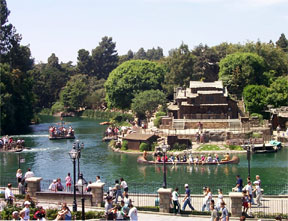 At that point Nathan thought he would be helpful. “Kara went back to the river to see the ducks,” he suggested. I had just checked the lake, with no sign of Kara. Without knowing it, Nathan had expressed my greatest fear precisely. Kara had gone to the lake to see the ducks, and had wandered in over her head.
At that point Nathan thought he would be helpful. “Kara went back to the river to see the ducks,” he suggested. I had just checked the lake, with no sign of Kara. Without knowing it, Nathan had expressed my greatest fear precisely. Kara had gone to the lake to see the ducks, and had wandered in over her head.
Linda and I told the Disneyland officials that Kara was lost and they sprang into immediate action. Soon dozens of employees had joined us in the search for our daughter. I remember running, literally, in larger and larger circles away from our lunch spot, all along calling for Kara. I didn’t care what anyone thought of me. All that mattered was finding my daughter . . . alive. Terrible thoughts entered my head, pictures of drowning, kidnapping, and so forth. I tried to blot them out of my mind, but couldn’t keep them from spilling back in. Of course I was praying, consistently, with ever increasing desperation. In my panic, I found it hard to think straight or to pray reasonably. It was as if my logical faculties had been strangled by the crushing grip of fear.
After about fifteen minutes, which felt like fifteen hours, I saw a Disneyland official carrying Kara back to our lunch spot. It turned out that a man near our table had been watching Kara play. He mistakenly thought she was part of another family. When that family left without her, he feared they had forgotten her. So he picked up Kara and went running off to find the other family. When he finally caught up with them, about ten minutes later, he was horrified to learn that she was not their child. So he immediately ran to bring Kara back, overflowing with apologies. Those moments holding Kara still are some of the most precious of my life. (At that point my adrenaline stopped pumping, and I was utterly exhausted. Kara, utterly unconcerned, just wanted to go on the Dumbo ride.)
If Peter felt anything like what I felt that fateful day, then I can understand why he denied Jesus. In saying this I’m not excusing his behavior. Not by a long shot. What Peter did was wrong. But I am saying that I can understand what he might have been feeling and why he did something that he later found so horrifying and inexcusable. Fear has to power to make all of us do or say that which we later regret.
Though you and I might never deny Jesus in such a blatant way as Peter did, I would suggest that we might indeed deny him is less obvious ways, also because of fear. Have you ever sensed that the Lord was urging you to do something for his sake, but then you chickened out because you were afraid? Have you known what it’s like to downplay the significance of your faith in some conversation because your were afraid of what people might think of you? Have you ever let fear keep you from experiencing the fullness of life in Christ? I know I have, too many times to count.
What is the antidote to such fear? It’s trusting God. It’s believing the Word of Christ. It’s experiencing the perfect love of God that casts out fear (1 John 4:18). We don’t conquer fear through rationalization and mind-control. Rather, we overcome fear by leaning more fully into the strong arms of God, and knowing that he will never let us go.
Prayer
Forgive me, dear Lord, when I let fear get in the way of my relationship with you. Forgive me for all the times I’ve fallen short in my discipleship because I’ve been afraid. Forgive me for failing to trust you when you’ve proven yourself to be so utterly worthy of trust.
Help me, Lord, not to be like Peter in this story. When hard times come, help me to trust you more. When my adrenaline starts to pound, clouding my mind and suffocating my heart, help me to receive your peace. When I’m tempted to deny you, either in words or deeds, or by failing to speak or act, help me to trust and obey. May I live my whole life in honor of you!
Amen.
Topics: Stations of the Cross | 1 Comment »





